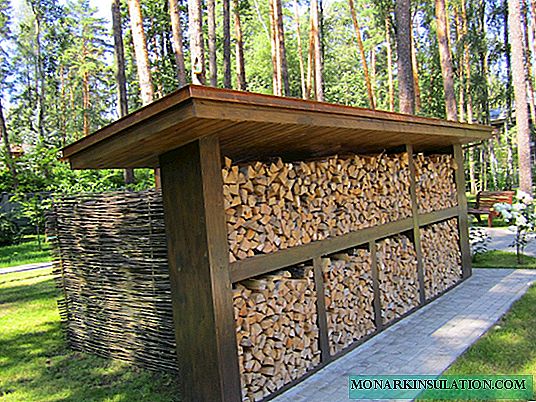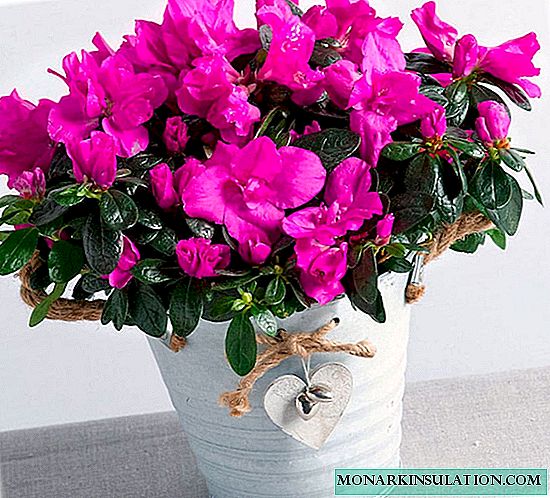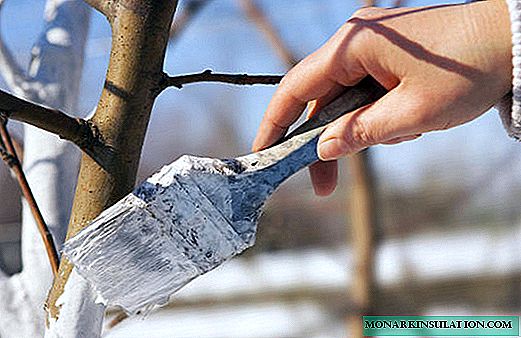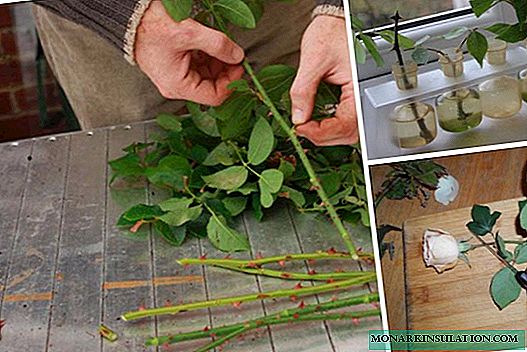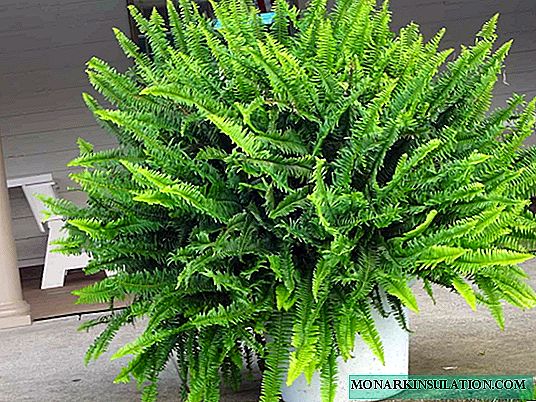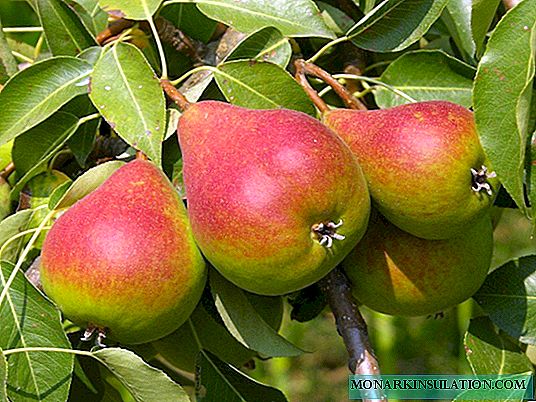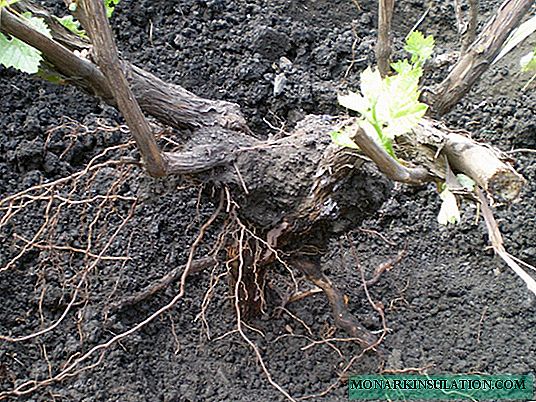
Inexperienced growers, who often make mistakes during the initial planting of grapes, later think about moving it to a new place. However, carrying out this procedure worries them, they are afraid of harming the plant and losing a valuable variety. In this article, beginners will find comprehensive answers to the main questions regarding the transplantation of the grape bush and will be able to start work with confidence.
Is it possible to transplant grapes
You can transfer grapes to a new place if necessary, which arises for various reasons:
- poorly selected place for planting a grape bush: poor lighting, the presence of drafts, poor soil quality;
- the features of the variety are not taken into account (for example, vigorous bushes planted too close to each other, the grouping by variety is violated)
- the negative impact of neighboring plants that interfere with the full growth of grapes;
- redevelopment of the garden;
- the need to move the bush to a new site.
But before you take up the shovel, you should analyze the feasibility of this event. After all, such an intervention in the vital activity of a plant is associated with certain consequences:
- there is a threat of death of the bush, which has lost part of the roots;
- violation of the fruiting of transplanted grapes for 2-3 years;
- change in the taste of berries;
- There is a risk of infection of the plant with dangerous diseases (for example, phylloxera or black cancer).

Do not transplant grapes to the place of a remote bush. It threatens with poor development and disease.
The key to successful transfer of grapes to a new place is the quality of the procedure in compliance with the basic nuances and rules of transplantation:
- A young bush up to 5 years old takes root and adapts faster to a new place.
- The time of transplantation should coincide with the stages of relative dormancy of the plant: early spring or mid-late autumn.
- The integrity of the root system should be maximally preserved: if possible, dig out and transfer the bush with an earthen lump.
- When moving the plant, it is necessary to maintain a balance between its aboveground and underground parts: a fair amount of vine pruning will be required.
- A new place must be prepared in advance.
- After transplanting, grapes will need careful care: frequent watering, loosening the soil, top dressing, and treatment for diseases and pests.
- In order to avoid depletion of the grape bush, you should not allow it to bear fruit for 1-2 years after transplanting, by removing the formed inflorescences.
When is it best to transplant grapes to a new place, taking into account the climate?
Like pruning of the vine, and transplanting the bush is best done during periods of comparative dormancy of the plant: in early spring or late autumn. Specific dates depend on the climate of the growing region and prevailing weather conditions. Spring transplantation is preferable for residents of areas with a cold climate - during the summer, the plant manages to take root and prepare for winter. In regions with dry summers, it is better to move grapes in autumn, since a fragile bush can die from drought and heat.
In some cases, a transplant can be made in the summer, but the success of the operation will be higher if the bush is moved with an earthen lump. Additionally, the plant will need protection from scorching sunlight.
Dates and features of spring movement
In spring, grapes are transplanted to a new place before the sap flow and bud swelling. In different regions, this moment occurs at different times, so it is better to focus on soil temperature. The optimal period is when the grape roots awaken and their growth begins. This happens when the earth warms up to an average of +80FROM.
It is preferable to carry out a spring transplant:
- in the south - at the end of March;
- in the middle lane - in the early to mid-April;
- in the northern regions - in late April - early May.

In spring, a bush transplant is recommended to be carried out before the kidney swells.
To activate the awakening of the roots, in the spring before planting, the planting hole is poured with hot water. After planting, the ground part of the plant is sprinkled with earth. This allows you to slow down the growth of shoots and leaves and gives time to restore the root system.
In 2006, I transplanted the whole vineyard to a new place, and this is more than 100 bushes. Two winegrowers helped me. In April, before the eyes swelled, in one day they dug bushes from the old vineyard and planted in a new place. The age of the bushes was from 2 to 5 years. Lunge amounted to 3 bushes. The only pity is that I had to remove all the sleeves in order to better take root. I am still restoring the aerial part.
Tamara Yashchenko//www.vinograd.alt.ru/forum/index.php?showtopic=221
Autumn transplant: timing and specifics
Grapes are transplanted in the fall in one and a half to two weeks after the plant drops its leaves.. At this time, the upper part of the bush comes to rest. But the root system, located in still warm soil, is quite active. Thanks to this, the plant will have time to take root in a new place before the onset of frost. A favorable period for moving the bush is:
- in the south - the first decade of November;
- in the middle lane - mid-end of October;
- in the northern regions - early to mid-October.
However, with an autumn transplant, there is always a risk of the bush dying from too early frosts. Therefore, choosing a specific date, gardeners should take into account weather forecasts and perform the procedure no later than two weeks before the expected temperature drop.
Another advantage of the autumn planting is frequent rainfall, eliminating the need for frequent watering of the transplanted bush.
Regardless of climate and variety, grapes transplanted to a new place in the autumn period require obligatory shelter for the winter.
What you need to know about the root system of grapes for proper transplantation
The formation of the root system of grapes begins immediately after planting a chubuk or seed. In the first years, the roots develop and grow most actively, and after six years of age they stop a little. The composition of the soil, as well as the quality of care for the bush in the first years of life, affect the characteristics of its root system.
The roots that make up the stem are divided into:
- dew, lying at a depth of 10 - 15 cm;
- median, which, depending on the length of the handle, can have 1 - 2 tiers;
- calcaneal (main), growing from the lower node of the handle and occurring most deeply.

An elementary idea of the structure of the grape bush allows its pruning and transplanting.
Each spine, regardless of location, consists of several zones:
- zones of active growth;
- absorption zones;
- conductive zone.
From the point of view of nutrition, the absorption zone, abundantly covered with white root hairs, is of the greatest importance. Their maximum accumulation is observed in those soil layers where optimal moisture, nutrition and aeration exist. During the growing season, the highest absorption activity and growth of root hairs occur at a depth of 30-60 cm, but during drought they are shifted to deeper layers. This point should be taken into account when transplanting grapes: if during the course of its life the grapes did not receive proper care in the form of loosening the soil and copious irrigation during dry periods, then it will have a deepened root system. Therefore, the bush will have to be dug deeper, so as not to damage the most active feeding areas of the roots.
The composition and quality of the soil to a large extent determine the characteristics of the formation of the root system of the bush. Planting a bush on previously untreated, heavy clay soils contributes to the formation of a shallow (20-25 cm) stem, consisting mainly of dew roots. This is the cause of freezing of grapes in frosty winters in the absence of snow, as well as drying out in the heat without regular watering. In this case, when digging a bush, it is necessary to preserve the existing middle and calcaneal roots as much as possible, because the dew will be pruned during transplantation.
If the landing pit was prepared qualitatively (deeply dug up and equipped with fertilizers), the roots of two or three year old grapes penetrate to a depth of more than 50 cm, growing horizontally in a radius of 60 cm, but their bulk is concentrated in a small soil volume of about 20-30 cm3.
In the spring, at the request of a neighbor, he transplanted a five-year-old Arched bush to his fence garden. Currently, the shoots on the transplanted Arched have started to grow. I consider this as a sign of the beginning of root growth. In order to verify this, I decided to partially dig out the heel roots of the bush. Initially, it was planted to a depth of 35 cm. As previous excavations showed, it turned out to be too deep, most of the calcaneal roots rushed into the warmer upper horizons. In this regard, when transplanting a bush to a new place, heel raised and a new planting was made to a depth of 15-20 cm. After transplanting, a bush can receive water only through sections of skeletal roots, so it is important when planting / replanting to shortly cut the skeletal roots no more than 15 cm So, in the second and third photos it is seen that at the ends of the skeletal roots, callus bursts formed, just as it happens on cuttings when rooted. These are the harbingers of the emergence of new white roots through which the bush can already receive water and nutrition. Shoots on the bush grew exclusively due to stocks stored in the tissues of the stem. Isolated white roots were also found. Thus, the bush is currently at the start of growth of a new root system.
Vlad-212//forum.vinograd.info/showthread.php?t=13121&highlight=%EF%E5%F0%E5%F1%E0%E4%EA%E0+%E2%E8%ED%EE%E3%F0%E0%E4 % E0 & page = 3
Take into account the age of the bush when transplanting
For a grape transplant to be successful, it is necessary to understand the features of its development at different ages. They will determine the width and depth of the trenching of the bush when it is removed to the surface. After all, maintaining the maximum integrity of the root system when digging up is one of the main tasks of a gardener when transplanting to a new place. Young bushes up to 5-6 years old are best tolerated by this procedure.
Moving two year old grapes
The root system of a two-year bush is already quite developed, therefore it is better to dig it at a distance of 30 cm from its base, the recommended depth when digging is 50-60 cm. When planting at a new place, the shoots are cut to 2-3 eyes.

You can transplant grapes at the age of 2 years without fear. If you dig it with an earthen lump, it easily adapts to a new location
Transplant of three year old grapes
The roots of three-year-old grapes penetrate the ground 90 cm, while most of them lie at a depth of 60 cm. The growth radius is 100 cm. It is better to dig a bush in a radius of 40-50 cm from the base, deepening by 70-80 cm. Before planting, spend pruning a bush to 4 eyes.
Video: transplanting a three-year-old grape bush
Moving four to five year old bushes
Digging up a 4-5 year old grape without damaging the roots is nearly impossible. They go deep into the ground by more than 100 cm, still concentrating the bulk at a depth of 60 cm. It is better to dig the bush at a distance of at least 50 cm from the base. Trim short, leaving 5-6 eyes.
Video: four-year-old grape transplant
How to transplant old grapes
The roots of a 6–7-year-old grape bush in the horizontal direction can grow up to 1.5 m, but 75% of them are still located in a radius of 60 cm at a depth of 10–60 cm. In an old 20-year-old grape plant, the roots are much thicker and thicker, they go deep into the soil up to 200 cm, and their active root zone is located in a radius of 80 cm at a depth of 10 - 120 cm.
Digging an old bush, you can cause significant damage to its root system, and in a new place a weakened plant simply does not take root. If there is a need to shift perennial grapes a short distance up to 2-2.5 m (for example, to bring the bush out of the shade of trees), experts recommend avoiding uprooting and carrying out the transfer of the plant by layering or by a method called “catavlak”. True, a lot of time will be required for this process.
Rooting in the new place by layering occurs due to the fact that a mature vine or green shoot is dug up by the soil. After some time (from several months to a year), it forms its own root system, still receiving food from the mother bush. Separate layers from the main plant is allowed only after 2 years. Then the old bush can be removed.

Propagation by layering allows you to update the old tree without extra costs, fill in the empty space on the site, grow future seedlings without harming the mother bush
Katavlak - a proven way to rejuvenate an old vine. Around the bush they dig a hole and free the root system so that the calcaneal roots appear. The strongest sleeve of the old bush or the entire bush is dumped into the trench, bringing young shoots to the surface. A plant that has grown in a new place begins to bear fruit in 1-2 years.

Katavlak is a type of grape propagation by layering, which allows you to move the bush to a new place and give a "second" life to the old bush
Video: how to transfer an old grape bush to a new place without rooting
How to transplant grapes
Moving grapes to a new place is carried out in several stages, from the selection of a new place to the planting of a dug bush. Consider what nuances you need to consider and how to properly transplant a bush, so that in the future the plant feels comfortable.
Choosing and preparing a place for a transplant
Grapes are a thermophilic plant, therefore, the correct choice of a new place for its residence is very important. The following subtleties must be considered:
- the site should be well lit, protected from wind and drafts;
- grapes do not like stagnation of moisture, so groundwater should not be closer than 1 m to the surface on the site;
- a plant located near the southern walls of buildings will receive more heat in the future;
- they do not recommend planting bushes near trees - as they grow, they will begin to obscure the grapes;
- grapes are undemanding to the composition of the soil, however, on wetland soils and salt marshes it is better not to plant it.
If you fertilize a new place with compost, it is important to remember that it should not contain the remains of vine leaves or vines. It is better to burn this waste and feed the bush with the resulting ash. So you can avoid infection with diseases.
The landing pit must be prepared at least one month before transplanting. Otherwise, the earth will begin to settle and provoke a deepening of the root system of the plant. When arranging a pit, the following requirements should be observed:
- the size of the depression depends on the age of the bush: the older the bush, the larger the pit should be - from 60 cm to 100 cm;
- the depth of the pit also depends on the composition of the soil: on light sandy soils - 50-60 cm, on heavy loams - at least 70-80 cm (at the bottom it is better to equip the drainage with expanded clay, gravel or broken brick);
- in regions with severe winters, the bush is placed deeper to protect the weakened roots from freezing;
- when moving a large number of bushes, the distance between them is determined based on the growth force of the bush: for dwarf bushes - at least 2 m; for vigorous - about 3 m;
- the lower part of the pit is filled with earth carefully mixed with organic (6-8 kg of humus) or mineral fertilizers (150-200 g of superphosphate, 75-100 g of ammonium sulfate and 200-300 g of wood ash).

To organize the nutrition of the roots in the dug hole, install a piece of asbestos or plastic pipe. Then the fertilizer solution will go straight to the destination
As iron-containing fertilizers can be rusty cans or nails, burned at the stake and added to the pit during transplantation.
How to dig and plant a bush in a new place
There are 3 ways to transplant grapes:
- with a full lump of soil (transshipment);
- with partial lump of soil;
- with a clean root system, without soil.
Transshipment is most preferable, since the roots located in the excavated coma of the earth are practically not damaged, the plant does not experience transplant stress and easily survives moving. As a rule, 2-3-year-old bushes are transplanted in this way, since it is almost impossible to move an earthen lump of enormous size with the roots of a more mature bush.
To transplant grapes by transshipment, you must:
- Suspend watering 3-4 days before the operation so that the earthen lump does not fall apart.
- Pruning the vine, taking into account the age of the bush and treat the places of cuts with garden var.
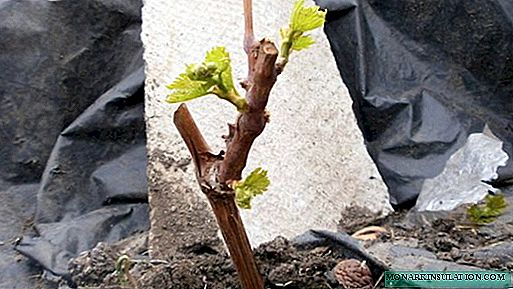
When transplanting grapes, a significant pruning of the young bush is performed, leaving 2-3 buds
- Carefully dig a bush around a circle with a diameter of 50-60 cm.

When digging a bush, you need to use a shovel very carefully so that as many roots as possible remain intact
- Gently get the plant with part of the earth, chopping off the longest roots.

The size of the extracted piece of land will depend on the age of the vine bush and the characteristics of its root system
- Move the bush to a new location. If it is too large, then you can transport it on a wheelbarrow or drag it onto a piece of tarpaulin or a sheet of metal.
- Place an earthen lump in a new hole, fill the cracks with soil, and ram.

A fragment of the soil is placed at the bottom of the pit, the rest of the space is carefully filled with earth
- Pour with two buckets of water and mulch with compost or peat 10 cm thick.
A transplant with partially or completely bare roots is carried out for adult bushes or if the earthen ball crumbled during excavation. You can do this this way:
- The day before the operation, the plant is watered abundantly.
The vine is dug at a distance of 50-60 cm from the base to the depth of the heel roots.
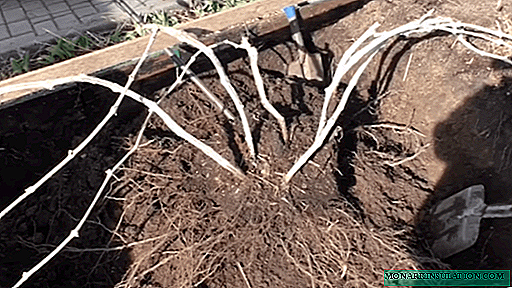
Initially, they dig a bush, as a rule, with a shovel, then, as they approach the roots, they resort to using a narrower tool (for example, a crowbar)
The bush rises neatly, the remnants of the earth stray from the roots by tapping with a stick.
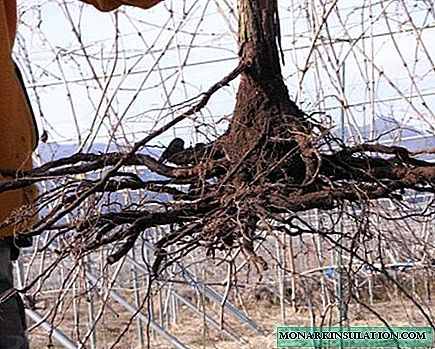
After removing from the pit and removing the earth, the state of the root system should be assessed.
The plant is removed from the pit. Roots are trimmed: mechanically damaged thick roots are trimmed and thin (0.5 - 2 cm) are trimmed, maintaining their maximum number; dew roots are cut completely.
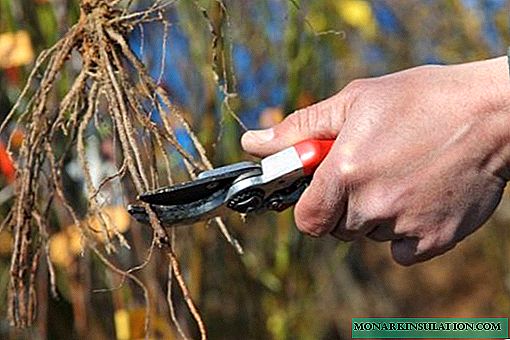
Proper pruning of grape roots during transplantation has a stimulating effect on the development of the root system in the future
The root system is immersed in a talker (1 part cow manure and 2 parts clay) creamy consistency.
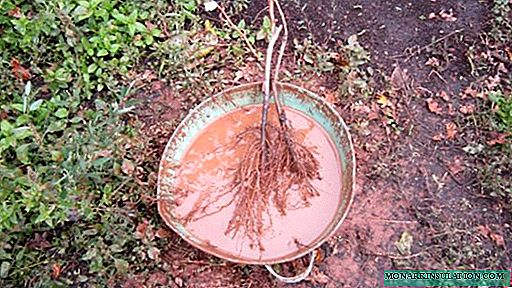
Grape root treatment reduces the risk of fungal infection
Pruning of the vine is carried out based on the state of the root system, between which a balance must be maintained. If the roots are badly damaged or the bush is older than 10 years, the ground part is cut to a “black head”. With a good root system of the bush, you can leave on it several sleeves with knots of substitution with two eyes on each.

When pruning the ground part of the grapes, you should not "regret" the bush. Short pruning will help the plant recover faster
Places of vine cuts are cultivated by garden var.

Gardening cuts speeds up wound healing
At the bottom of the new pit, a small mound is formed, on the surface of which the heel roots straighten.
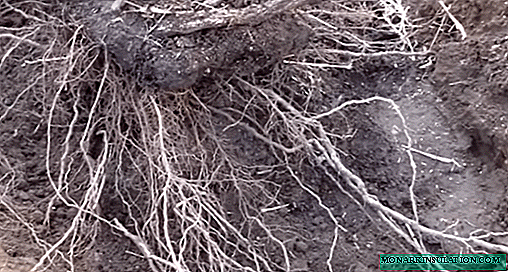
Having placed the root stem on an earthen mound, it is necessary to straighten all the roots so that they are straight and not confused with each other
The pit is filled with earth to the next tier of roots, which are also spread on the ground and sprinkled.
The soil is compacted, irrigated with two buckets of water, mulching with peat or leaves.
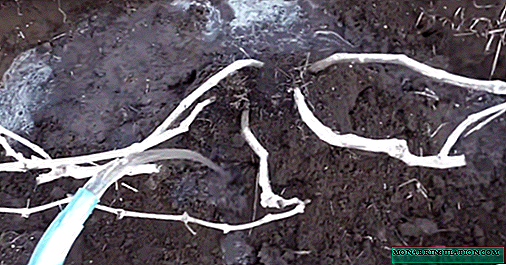
After transplanting to a new place, the bush will need frequent, regular watering
Many believe that if you add 200-300 g of barley grains to the pit during planting, then the bush will take root better.
The author of this article was able to observe how a neighbor in the plot transplanted four-year-old grapes in the fall. He performed this operation without preserving an earthen coma: he carefully dug a shovel around the perimeter of 60 cm. Gradually approaching the base, he reached the calcaneal roots, which were located at a depth of about 40-45 cm. Then he stopped digging and went for water. He poured the pit thoroughly and left for three hours. Then, carefully, he manually pulled out all the roots from the earthen slurry. So he managed to keep the root system in complete integrity. True, tinkering in the mud had to be pretty. But the result was worth it - in the spring the grape bush actively went into growth, and the next year gave a harvest.
After transplanting, weakened grapes with damaged roots require special care: frequent watering, fertilizing, pest control and mandatory winter shelter for several years.
There is experience in transplanting bushes of 4-5 summer bushes. Technicians. I dug as far as I could and could save the maximum length of the roots. When planting, the root deepened deeper than in the old place. It cut off the aerial part comparable to the underground part, even leaving it a little less above the ground. For a year or two it slowed down the bush, but on the other hand the variety remained and then gained its “momentum” and even increased.
mykhalych//forum.vinograd.info/showthread.php?t=13121&highlight=%EF%E5%F0%E5%F1%E0%E4%EA%E0+%E2%E8%ED%EE%E3%F0%E0%E4 % E0 & page = 3
Regardless of the reasons for which you decided to transplant the grapes, it should be remembered that this procedure for the bush does not pass without a trace. And if transplantation cannot be avoided, then this should be done taking into account the age of the plant, climatic conditions and weather outside the window, preserving the integrity of the root system and maintaining a balance between the volumes of the ground and underground parts. Do not forget about thorough care after transplantation. Then, after 2-3 years, the vine recovered in a new place will please its harvest.















